Table of Contents
ToggleNCERT Solutions Class 10 Science Chapter 4 (Carbon and its Compounds)
NCERT Solutions for Class 10 Science Chapter 4 Intext Questions
NCERT Solutions Class 10 Science Chapter 4 (Carbon and Its Compounds)
Page Number: 61
Question 1
What would be the electron dot structure of carbon dioxide which has the formula CO2 ?
Answer:

Question 2
What would be the electron dot structure of a molecule of sulphur which is made up of eight atoms of sulphur?
Answer:
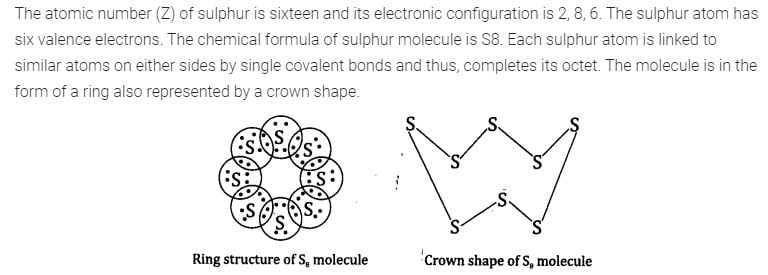
NCERT Solutions Class 10 Science Chapter 4 (Carbon and Its Compounds)
Page Number: 68-69
Question 1
How many structural isomers can you draw for pentane?
Answer:

Question 2
What are the two properties of carbon which lead to the huge number of carbon compounds we see around us ?
Answer:

Question 3
What will be the formula and electron dot structure of cyclopentane ?
Answer:

Question 4
Draw the structures for the following compounds :
(i) Ethanoic acid
(ii) Bromopentane
(iii) Butanone
(iv) Hexanal
Answer:

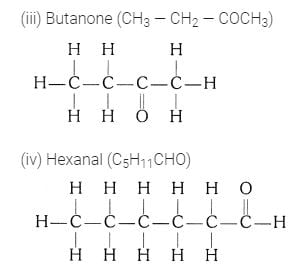

Question 5
How would you name the following compounds ?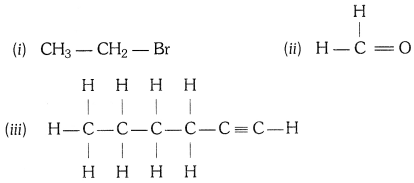
Answer:

NCERT Solutions Class 10 Science Chapter 4 (Carbon and Its Compounds)
Page Number: 71
Question 1
Why is the conversion of ethanol to ethanoic acid an oxidation reaction ?
Answer:

Question 2
A mixture of oxygen and ethyne is burnt for welding. Can you tell why a mixture of ethyne and air is not used ?
Answer:

NCERT Solutions Class 10 Science Chapter 4 (Carbon and Its Compounds)
Page Number: 74
Question 1
How would you distinguish experimentally between an alcohol and a carboxylic acid ?
Answer:
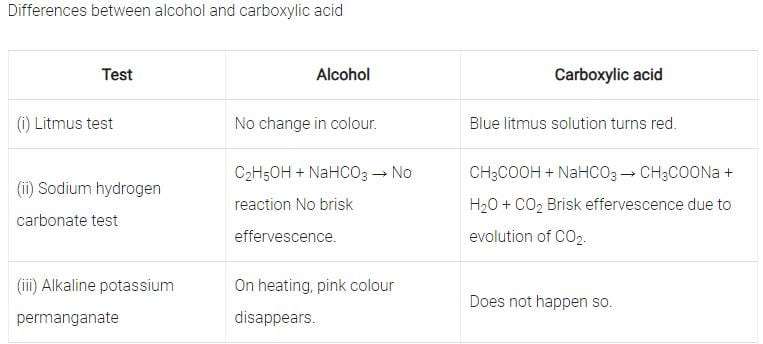
Question 2
What are oxidising agents ?
Answer:

NCERT Solutions Class 10 Science Chapter 4 (Carbon and Its Compounds)
Page Number: 76
Question 1
Would you be able to check if water is hard by using a detergent ?
Answer:

Question 2
People use a variety of methods to wash clothes. Usually after adding the soap, they ‘beat’ the clothes on a stone, or beat it with a paddle, scrub with a brush or the mixture is agitated in a washing machine. Why is agitation necessary to get clean clothes ?
Answer:

NCERT Solutions for Class 10 Science Chapter 4 Exercise Questions (Textbook Chapter End Questions)
NCERT Solutions Class 10 Science Chapter 4
Question 1
Ethane, with the molecular formula C2H6 has
(a) 6 covalent bonds
(b) 7 covalent bonds
(c) 8 covalent bonds
(d) 9 covalent bonds
Answer:
Question 2
Butanone is a four carbon compound with the functional group
(a) carboxylic acid
(b) aldehyde
(c) ketone
(d) alcohol
Answer:
Question 3
While cooking, if the bottom of the vessel is blackened on the outside, it means that
(a) the food is not cooked completely
(b) the fuel is not burning completely
(c) the fuel is wet
(d) the fuel is burning completely.
Answer:
Question 4
Explain the nature of the covalent bond using the bond formation in CH3Cl.
Answer:

Question 5
Draw the electron dot structures for
(a) ethanoic acid
(b) H2S
(c) propanone
(d) F2
Answer:
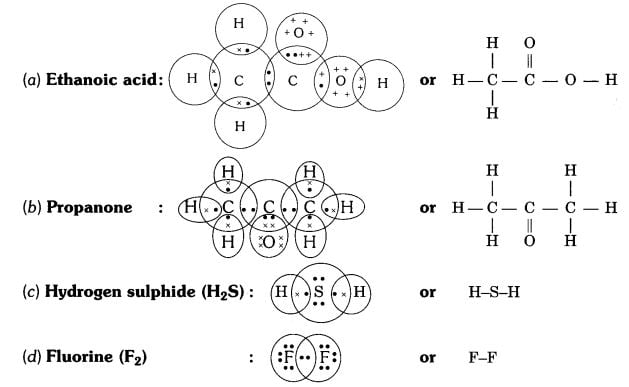
Question 6
What is a homologous series ? Explain with an example.
Answer:

Question 7
How can ethanol and ethanoic acid he differentiated on the basis of their physical and chemical properties ?
Answer:

Question 8
Why does micelle formation take place when soap is added to water? Will a micelle be formed in other solvents such as ethanol also?
Answer:

Question 9
Why are carbon and its compounds used as fuels in most cases?
Answer:

Question 10
Explain the formation of scum when hard water is treated with soap.
Answer:

Question 11
What change will you observe by testing soap with litmus paper (blue or red)?
Answer:

Question 12
What is hydrogenation? What is its industrial application?
Answer:
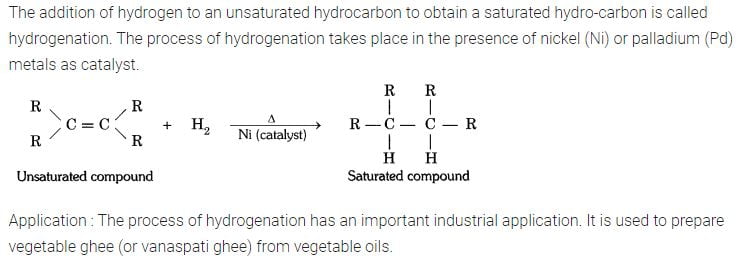
Question 13
Which of the listed hydrocarbons undergo addition reactions: C2H6, C3H8, C3H6, C2H2 and CH4?
Answer:

Question 14
Give a test that can be used to differentiate between saturated and unsaturated hydrocarbons.
Or
Give a test that can be used to differentiate between butter and cooking oil.
Answer:

Question 15
Explain the mechanism of cleansing action of soap.
Answer:

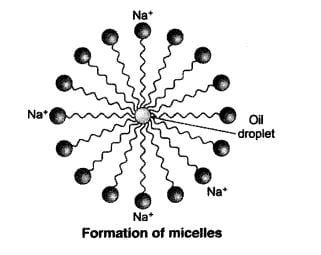

NCERT Solutions Class 10 Science Chapter 4 Carbon and its compounds Provided by Bhautik Study covers all the essential subjects in great detail to aid in students’ comprehension of the material. NCERT Solutions Class 10 Science Chapter 4 Chemical Reactions and Equations NCERT Solutions are required reading for students getting ready for their exams. You can review the entire syllabus and earn more marks by using the answers to all of the Chapter 4: Carbon and its compounds
Let’s take a quick look at a list of themes and subtopics under NCERT Solutions Class 10 Science Chapter 4 Carbon and its compounds before delving into the specifics of the NCERT Solutions Class 10 Science Chapter 4 Carbon and its compounds:
1) Equations And Chemical Reactions
2) Chemical Formulas
3) Chemical Reaction Types
4) Have You Noticed How Oxidation Reactions Affect Your Daily Life? Y Life?
Characteristics of NCERT Solutions Class 10 Chapter 4 Science Pupils might receive extensive instruction in balancing various types of equations.
-With the help of the CBSE Class 10 Chemistry learning tools, discover how to write a balanced chemical equation and learn about chemical reactions.
-You can write different chemical equations correctly with the aid of NCERT Solution. aids in providing you with extensive practice answering questions of various levels of difficulty before the main exam.
-When completing homework assignments and getting ready for tests, our extensive collection of study materials serves as an ideal roadmap.
-Our specialists at Bhautikstudy.com help you learn chemistry by providing CBSE Class 10 Chemistry notes, MCQs, and NCERT solutions that follow the most recent syllabus.
By using the Bhautikstudy.com NCERT Solutions Learning App on your smartphone, you can access free conceptual videos and LIVE master classes. Learn the NCERT Solutions Class 10 Science Chapter 4 (Carbon and its compounds) NCERT Book Solution in detail from knowledgeable science instructors.
Having a thorough understanding of the material and practicing will help you get 100% on the questions in this chapter. It’s now simple to learn the principles of chemistry in CBSE Class 10.
We hope that this comprehensive set of NCERT Solutions will be useful to you now that you have all the information you need to solve the Chemical Reactions NCERT Solutions Science Chapter 4 problems. Bhautikstudy.com offers free access to NCERT Books, CBSE Syllabus, CBSE Sample Papers, and RD Sharma Solutions for students.
Excellent study materials are required for students studying in Class 10 CBSE Chemistry Chapter 4 Carbon and its compounds, according to NCERT Solutions Class 10 Science Chapter 4. Subject matter specialists at Bhautik Study have created these NCERT Solutions in accordance with the most recent CBSE Syllabus. It is crucial that students use NCERT Solutions Class 10 Science Chapter 4 to assist them learn how to solve and study so they can become familiar with the kinds of questions that are posed in the chapter as well as chemical reactions and equations.
The key topics covered in Chapter 4 of NCERT Solutions Class 10 Science Chapter 4 are creating chemical equations and writing and balancing equations. Additionally, students study the fundamentals of chemical reactions in this chapter, along with their various varieties and the practical applications of chemical oxidation reactions. An summary of the chapter’s key ideas is given in the NCERT Solutions Class 10 Science Chapter 4, which also helps students become knowledgeable about crucial subjects like creating and balancing chemical equations.
There are about four problems from Science Chapter 4 of the Class 10 NCERT Solutions each year, and they carry a good weight. The majority of the questions in this chapter are practice-based questions.
In our daily lives, chemical reactions are significant phenomena. Numerous chemical reactions occur in daily life, such as the rusting of iron, the curdling of milk, respiration, digestion, and development. Students need to practise using this NCERT Solution Class 10 Science Chapter 4 in order to do well on the CBSE Class 10 test.